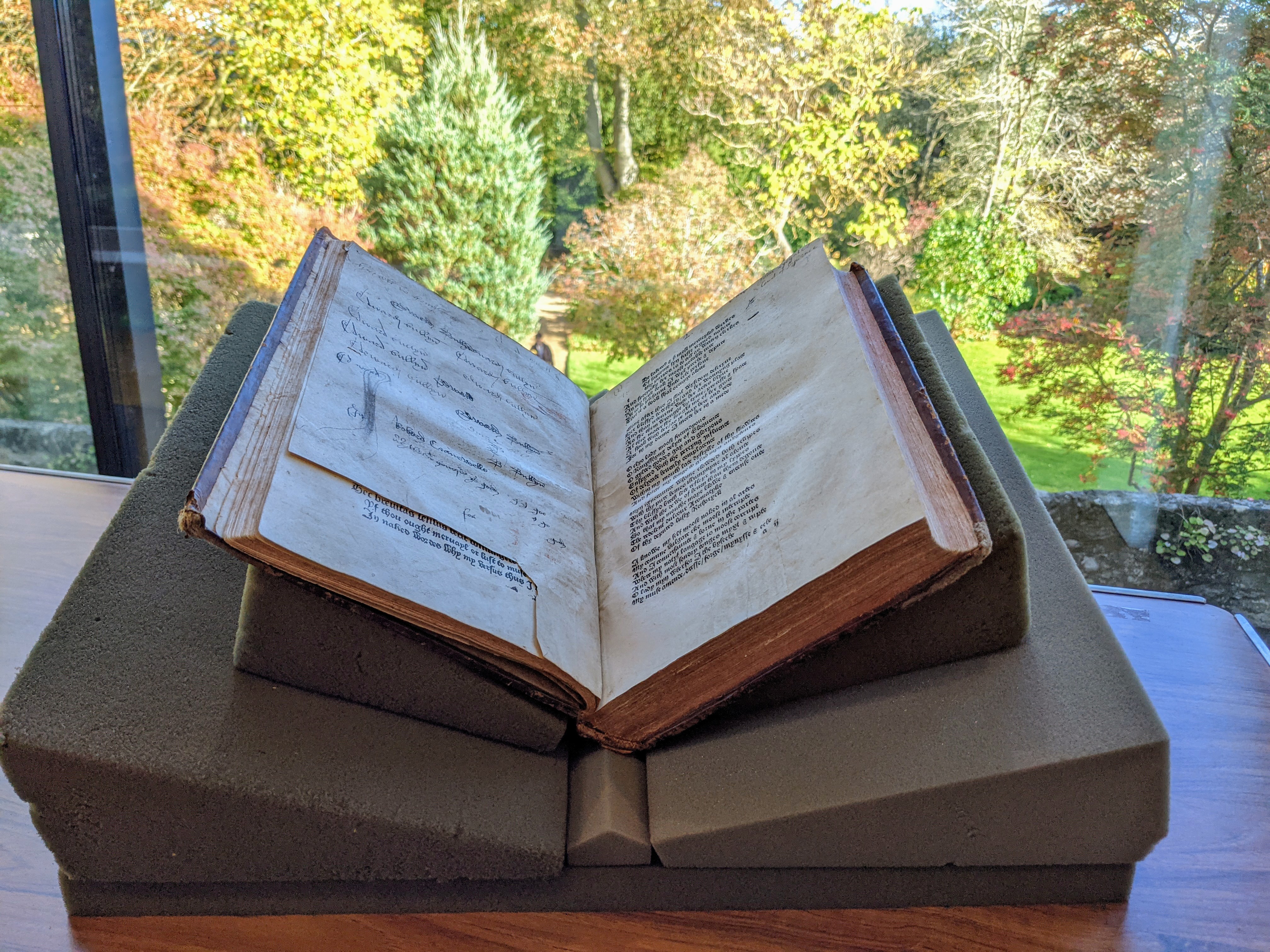The aspect of the St John’s Library traineeship I perhaps most looked forward to was getting involved with the manuscripts and early printed books. Here are four of the Special Collections tasks I’ve been working on over my first couple of months, and a look at what’s coming next!
1. “Book first aid”

Although many colleges with historic collections work with the Oxford Conservation Consortium to preserve and repair their items, in-house we perform “book first aid” to minimize further damage. I found that the front board of this bound volume of tracts had detached. The aim of the “first aid” tying is to prevent damage to the page block, and keep the parts of the volume together. When tying, it’s important to put the knots on the fore edge side (pages) to avoid them pressing into the spine. Another consideration is choosing a cotton tape of a similar shade to achieve a discreet look. Previously, we only stocked cream tape, so one of my tasks over the students’ Christmas vacation will be to replace individual cream tapes with pairs of tonal tapes on our many taped volumes.
2. Invigilating of readers

Invigilating readers feels like a bit of a role reversal for me, as a former history student. When a researcher scheduled a visit to study our 15th century Caxton volumes, I was asked to invigilate for the first time. The Librarian and I allotted an hour to find the material and pre-prepare the best book rest set up to avoid damaging the volumes. Once the reader arrives, there are a couple of forms to fill in. Having now invigilated several times, my initial nerves have vanished, but I am still careful not to let the manuscript or book out of my sight.
3. Finding aids

Since the renovations started on our early modern libraries, the historic collections have been moved into storage in the new building. One of my first ongoing projects was creating a shelf guide for one of the basement stores to act as a finding aid. Excitingly, I was also given license to examine any books which particularly intrigued me. This was to help with task 4, although if I’d stopped to read all of the interesting ones, I’d still be in the basement right now!
4. Creating Twitter content

St John’s Library has a Twitter account dedicated to our Special Collections (go on, give us a follow at @StJohnsOxLib). Whenever I’m down in the store room, I keep my eyes peeled for Tweetable content. Usually, I hunt for intriguing bookplates, marginalia, or images which will make eye-catching photos, and then write up a brief explanation. Creating the most engaged-with content has become a bit of a friendly competition between myself and the Senior Library Assistant (Former trainee, Dom Hewett, English Faculty Library | Oxford Libraries Graduate Trainees). Creating twitter content is fun because it’s hard to predict what will take off. That being said, we are both hoping that by tracking the Twitter analytics more closely, we’ll get better at that part.
5. What’s next?
St John’s Library operates a Special Collections blog, as well as a Twitter. Currently, I am researching for a new blog post, featuring one of the manuscripts and one of the pamphlets from our early modern collection. These items captured my attention because they are two very different forms of autobiographical writing by executed female criminals, so I feel lucky to be able to pursue my interest in them further, whilst hopefully creating content others can enjoy too. If you are interested in finding out more about the Special Collections at St John’s, or are eager to apply for a traineeship here, check out the blog at St John’s College Library, Oxford (stjohnscollegelibraryoxford.org)

So far, I’ve found working with the Special Collections to be incredibly rewarding. When working with early printed books and manuscripts, taking care is dramatically prioritized over acting quickly. However, working with Special Collections is not just about hiding books in the basement – and it’s fascinating to meet the visiting researchers to hear about how the items they consult will shape their scholarship. In the future, I hope to continue developing my Special Collections skills, particularly in terms of making material available to wider audiences in person, for example through exhibitions and visitor sessions (when the pandemic permits!).
